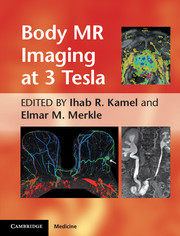Book contents
- Frontmatter
- Contents
- Contributors
- Foreword
- Preface
- Chapter 1 Body MR imaging at 3T: basic considerations about artifacts and safety
- Chapter 2 Novel acquisition techniques that are facilitated by 3T
- Chapter 3 Breast MR imaging
- Chapter 4 Cardiac MR imaging
- Chapter 5 Abdominal and pelvic MR angiography
- Chapter 6 Liver MR imaging at 3T: challenges and opportunities
- Chapter 7 MR imaging of the pancreas
- Chapter 8 MR imaging of the adrenal glands
- Chapter 9 Magnetic resonance cholangiopancreatography
- Chapter 10 MR imaging of small and large bowel
- Chapter 11 MR imaging of the rectum, 3T vs. 1.5T
- Chapter 12 Imaging of the kidneys and MR urography at 3T
- Chapter 13 MR imaging and MR-guided biopsy of the prostate at 3T
- Chapter 14 Female pelvic imaging at 3T
- Index
- Plate section
- References
Chapter 10 - MR imaging of small and large bowel
Published online by Cambridge University Press: 05 August 2011
- Frontmatter
- Contents
- Contributors
- Foreword
- Preface
- Chapter 1 Body MR imaging at 3T: basic considerations about artifacts and safety
- Chapter 2 Novel acquisition techniques that are facilitated by 3T
- Chapter 3 Breast MR imaging
- Chapter 4 Cardiac MR imaging
- Chapter 5 Abdominal and pelvic MR angiography
- Chapter 6 Liver MR imaging at 3T: challenges and opportunities
- Chapter 7 MR imaging of the pancreas
- Chapter 8 MR imaging of the adrenal glands
- Chapter 9 Magnetic resonance cholangiopancreatography
- Chapter 10 MR imaging of small and large bowel
- Chapter 11 MR imaging of the rectum, 3T vs. 1.5T
- Chapter 12 Imaging of the kidneys and MR urography at 3T
- Chapter 13 MR imaging and MR-guided biopsy of the prostate at 3T
- Chapter 14 Female pelvic imaging at 3T
- Index
- Plate section
- References
Summary
Introduction
The bowel is an organ which was not easily and accurately assessable until the introduction of cross-sectional imaging and newer endoscopic techniques. The location, length, and bowel peristalsis were major hurdles which were first overcome by the introduction of conventional radiology. Barium follow-through examinations and conventional enteroclysis gave valuable information on the presence of stenoses and mucosal lesions while barium enema and double contrast barium enema were used primarily for detection of colorectal cancer and its precursors (adenomatous polyps). Disadvantages of these techniques were the lack of detailed information on both mural and extramural abnormalities and the resulting mediocre accuracy. Furthermore, the ionizing radiation exposure was a major drawback of these examinations especially as these often have to be repeated for treatment monitoring or screening of disease recurrence.
- Type
- Chapter
- Information
- Body MR Imaging at 3 Tesla , pp. 134 - 149Publisher: Cambridge University PressPrint publication year: 2011



